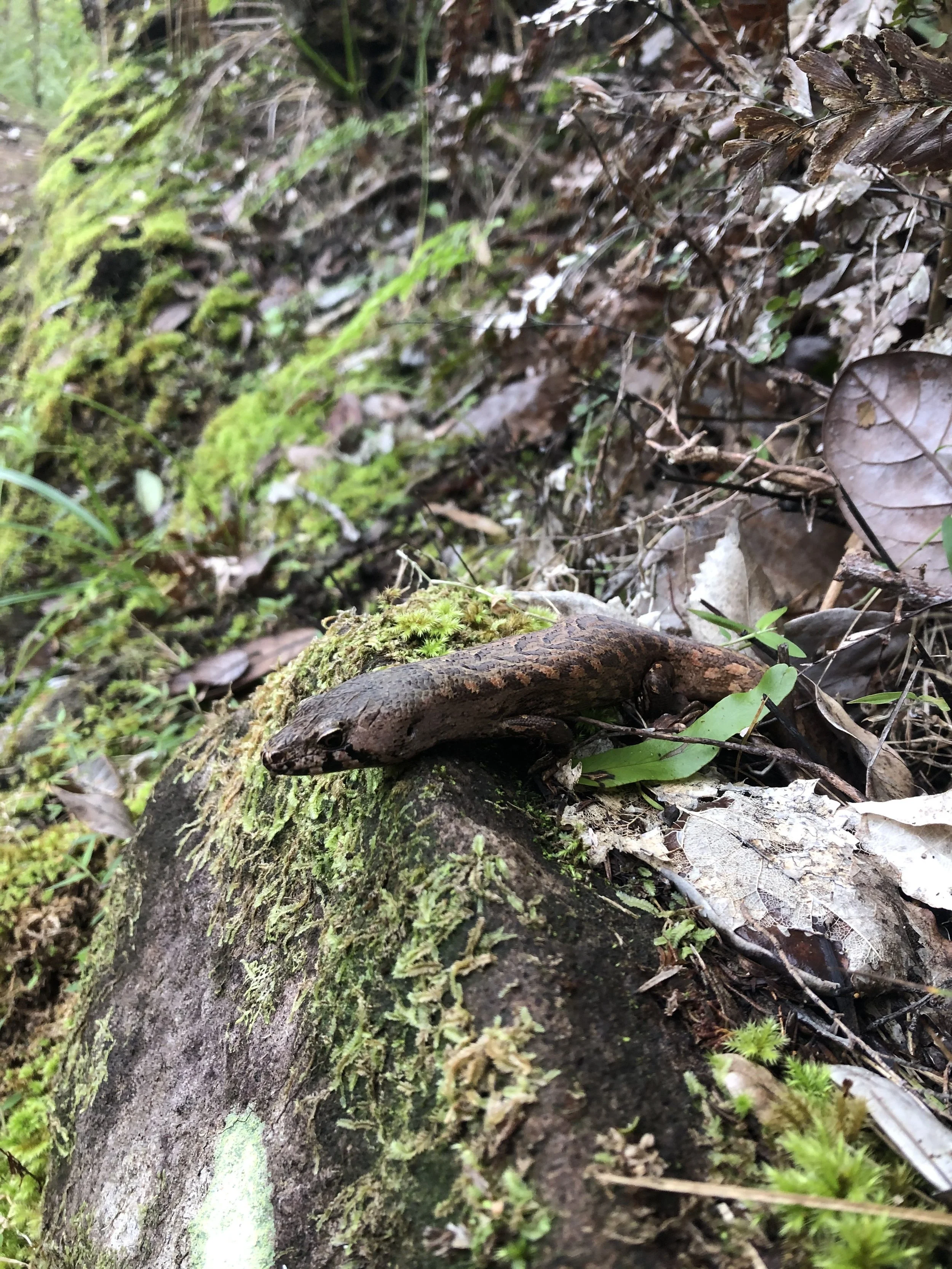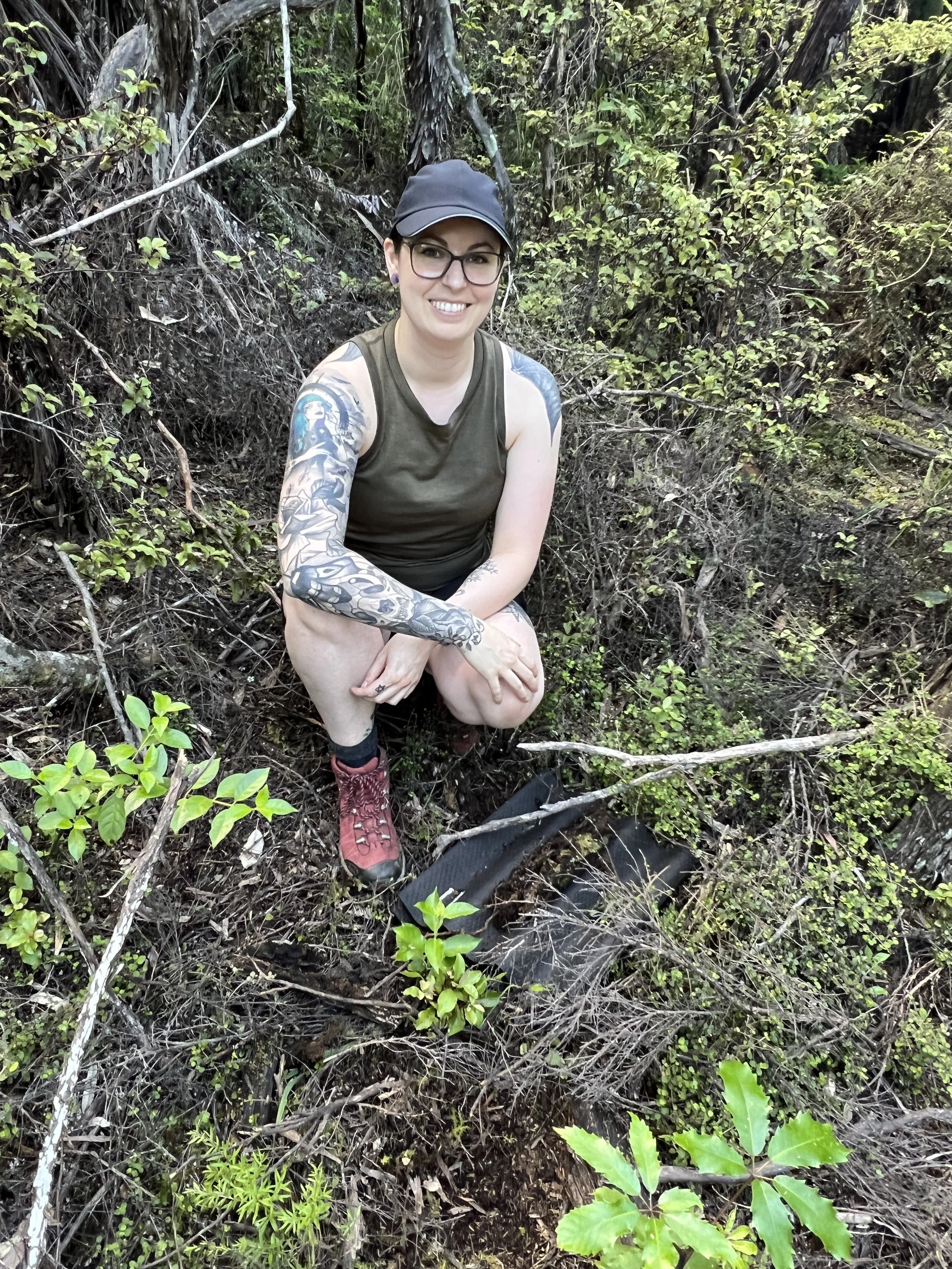Tails of Survival: The Lizards Holding on Across Aotea
HAYLEY ALENA (The University of Auckland)
Niho taniwha/chevron skink near a stream on Aotea
The land of lizards
Aotearoa is a global hotspot for lizard biodiversity, with at least 126 species found nowhere else in the world. The term ‘lizard’ or mokomoko in te reo Māori, refers to skinks and geckos. These unique creatures inhabit a wide range of environments across the motu – from coastal shrublands and native forests to sub-alpine and alpine regions. Since the arrival of humans and their introduction of mammalian pests in the 13th century, lizards have experienced severe declines and local extinctions. As a result, many are now restricted to small geographic ranges, offshore islands, and predator-free areas. There is one confirmed lizard extinction – The Northland skink (Oligosoma northlandi) and possibly a second: the giant gecko known as the kawekaweau (previously thought to be Hoplodactylus delcourti). Just one introduced lizard is present in Aotearoa, the plague or rainbow skink, which may compete with native species. With nearly a third of native bird species lost since human arrival, lizards now represent the largest group of remaining native terrestrial vertebrates in Aotearoa. Of the remaining native lizard species, 36% are threatened with extinction, and a further 50% are at risk of extinction.
Meet the locals
A juvenile Pacific gecko inside a letter box on Aotea
Aotea is home to 13 of these species – eight skink species and five gecko species, several of which I was fortunate to study during my PhD. Lizards are particularly vulnerable to predation by introduced pests such as rats and cats, and the low numbers of these across some of Aotea allow certain species to exist in higher abundances than on the mainland. The most common skinks on the island include the forest dwelling ornate skinks, and copper and moko skinks which occur in the forest and around the shore. Many residents and visitors to the island will also be familiar with the stunning Niho taniwha (chevron skink), one of the largest lizards in New Zealand, which may have once been present on the mainland but now only exists on Aotea and Te Hauturu-o-Toi. Chevron skinks are prone to water loss through their skin, so often live in the forest near stream margins, but are surprisingly sometimes found around houses on the island.
The most common geckos are Pacific and Raukawa geckos, which are often seen keeping warm around houses, but both also inhabit the forest, and Raukawa geckos also occur on the shore. Shore skinks and forest geckos are present on the island but are low in abundance, and the remaining species are extremely rare (striped skinks, egg-laying skinks, Hauraki skinks, Auckland green geckos and Duvaucel’s geckos).
The role of lizards
A Pacific gecko surrounded by prickly mingimingi on Aotea
New Zealand lizards, including those on Aotea, are involved in important ecosystem services such as seed dispersal and possibly pollination. At least twenty-eight species of lizards in New Zealand consume fruits from thirty-five fleshy-fruited plants and likely act as effective seed dispersers where lizard populations are high. On Aotea, I found evidence that lizards consumed fruits of several native plant species – pōhuehue, turutu, hangehange, red mapou, tōtara, nertera/fruiting duckweed, and coprosma species. I examined fruit removal rates by lizards and birds for some of these plant species (turutu/Dianella nigra, Coprosma rhamnoides and Coprosma spathulata) and found lizards on Aotea removed more fruits from these plant species than birds did at some sites. These findings suggest lizards contribute to seed dispersal on Aotea and may be important for the persistence of some plants. Although lizards on Aotea probably only move short distances, moving seeds away from parent plants even a few meters can improve plant germination and survival. Pollination by lizards on Aotea has not yet been studied, and studies elsewhere in New Zealand are limited, but there is some evidence that moko skinks and Duvaucel’s geckos feed on flowers and nectar and may be involved in pollination.
Uncertain futures
Of the 13 lizards on the island, one is threatened with extinction (chevron skinks), two are not threatened (Raukawa and Pacific geckos), and the remaining ten are at risk of extinction. However, these national classifications may not accurately reflect local populations on Aotea. In fact, three species may be heading towards extinction on Aotea. According to The Department of Conservation, Auckland green geckos were last sighted in 2009 (two individuals), egg-laying skinks were last sighted in 2004 (one individual), and a single Duvaucel’s gecko was sighted in 2010. The Duvaucel’s gecko was the first sighting in 40 years, and despite extensive searches, no other individuals have been found. There are no confirmed extinctions of lizards on the island, although the tuatara (which is reptile, but not a lizard) was once present but is now absent. New Zealand lizards are difficult to find and monitor due to their low abundances and cryptic nature, so there is still hope that remnant populations of Auckland green geckos, egg-laying skinks and Duvaucel’s geckos persist on the island.
How you can help
Hayley studying seed dispersal by lizards on Aotea by collecting lizard faeces from artificial refuges comprised of two pieces of onduline roofing material
Fortunately, there are ways we can help Aotea’s lizard populations. Several projects on the island – including Windy Hill Sanctuary, Glenfern Sanctuary and Oruawharo Medlands Ecovision – help protect lizards by trapping rodents and feral cats. Residents can help by setting rat traps around their properties to provide safe refuges for species like the chevron skink, Pacific gecko and Raukawa gecko. Cats are a major threat to native lizards, and since most geckos are nocturnal, keeping pet cats indoors at night can make a big difference. Skinks, being active during the day, are harder to protect — but keeping cats inside as much as possible can help. Creating lizard-friendly gardens is another way to support lizard populations, and Predator Free New Zealand offers excellent tips on how to do this – see the attached guide.
Native lizards may be susceptible to predation by plague/rainbow skinks, which are present on Aotea around Tryphena wharf. Plague skinks look similar to copper and ornate skinks, but are generally much smaller, faster, and have iridescent scales. Any suspected sightings should be reported to Auckland Council to prevent future spread. Plague skinks are extremely common on the mainland and are frequent hitchhikers, especially in soil, plants and construction materials. Carefully checking items before bringing them to Aotea — particularly from garden centres or supply depots — can help keep the island a safe haven for native lizards.
Ultimately, the future of Aotea’s lizards depends on a shared commitment to protecting and restoring their habitats. These unique creatures play important roles in our ecosystems, and continued efforts will help ensure that Aotea remains a stronghold for New Zealand’s incredible lizard diversity.





